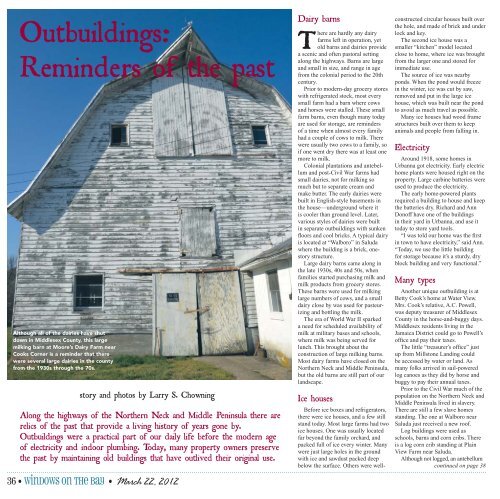03.22 WB pages 01-03.indd - The Rappahannock Record
03.22 WB pages 01-03.indd - The Rappahannock Record
03.22 WB pages 01-03.indd - The Rappahannock Record
You also want an ePaper? Increase the reach of your titles
YUMPU automatically turns print PDFs into web optimized ePapers that Google loves.
Outbuildings:Reminders of the pastAlthough all of the dairies have shutdown in Middlesex County, this largemilking barn at Moore’s Dairy Farm nearCooks Corner is a reminder that therewere several large dairies in the countyfrom the 1930s through the 70s.story and photos by Larry S. ChowningAlong the highways of the Northern Neck and Middle Peninsula there arerelics of the past that provide a living history of years gone by.Outbuildings were a practical part of our daily life before the modern ageof electricity and indoor plumbing. Today, many property owners preservethe past by maintaining old buildings that have outlived their original use.36 • windows on the Bay • Dairy barns<strong>The</strong>re are hardly any dairyfarms left in operation, yetold barns and dairies providea scenic and often pastoral settingalong the highways. Barns are largeand small in size, and range in agefrom the colonial period to the 20thcentury.Prior to modern-day grocery storeswith refrigerated stock, most everysmall farm had a barn where cowsand horses were stalled. <strong>The</strong>se smallfarm barns, even though many todayare used for storage, are remindersof a time when almost every familyhad a couple of cows to milk. <strong>The</strong>rewere usually two cows to a family, soif one went dry there was at least onemore to milk.Colonial plantations and antebellumand post-Civil War farms hadsmall dairies, not for milking somuch but to separate cream andmake butter. <strong>The</strong> early dairies werebuilt in English-style basements inthe house—underground where itis cooler than ground level. Later,various styles of dairies were builtin separate outbuildings with sunkenfloors and cool bricks. A typical dairyis located at “Walboro” in Saludawhere the building is a brick, onestorystructure.Large dairy barns came along inthe late 1930s, 40s and 50s, whenfamilies started purchasing milk andmilk products from grocery stores.<strong>The</strong>se barns were used for milkinglarge numbers of cows, and a smalldairy close by was used for pasteurizingand bottling the milk.<strong>The</strong> era of World War II sparkeda need for scheduled availability ofmilk at military bases and schools,where milk was being served forlunch. This brought about theconstruction of large milking barns.Most dairy farms have closed on theNorthern Neck and Middle Peninsula,but the old barns are still part of ourlandscape.Ice housesBefore ice boxes and refrigerators,there were ice houses, and a few stillstand today. Most large farms had twoice houses. One was usually locatedfar beyond the family orchard, andpacked full of ice every winter. Manywere just large holes in the groundwith ice and sawdust packed deepbelow the surface. Others were wellconstructedcircular houses built overthe hole, and made of brick and underlock and key.<strong>The</strong> second ice house was asmaller “kitchen” model locatedclose to home, where ice was broughtfrom the larger one and stored forimmediate use.<strong>The</strong> source of ice was nearbyponds. When the pond would freezein the winter, ice was cut by saw,removed and put in the large icehouse, which was built near the pondto avoid as much travel as possible.Many ice houses had wood framestructures built over them to keepanimals and people from falling in.ElectricityAround 1918, some homes inUrbanna got electricity. Early electrichome plants were housed right on theproperty. Large carbine batteries wereused to produce the electricity.<strong>The</strong> early home-powered plantsrequired a building to house and keepthe batteries dry. Richard and AnnDonoff have one of the buildingsin their yard in Urbanna, and use ittoday to store yard tools.“I was told our home was the firstin town to have electricity,” said Ann.“Today, we use the little buildingfor storage because it’s a sturdy, dryblock building and very functional.”Many typesAnother unique outbuilding is atBetty Cook’s home at Water View.Mrs. Cook’s relative, A.C. Powell,was deputy treasurer of MiddlesexCounty in the horse-and-buggy days.Middlesex residents living in theJamaica District could go to Powell’soffice and pay their taxes.<strong>The</strong> little “treasurer’s office” justup from Millstone Landing couldbe accessed by water or land. Asmany folks arrived in sail-poweredlog canoes as they did by horse andbuggy to pay their annual taxes.Prior to the Civil War much of thepopulation on the Northern Neck andMiddle Peninsula lived in slavery.<strong>The</strong>re are still a few slave homesstanding. <strong>The</strong> one at Walboro nearSaluda just received a new roof.Log buildings were used asschools, barns and corn cribs. <strong>The</strong>reis a log corn crib standing at PlainView Farm near Saluda.Although not logged, an antebellumcontinued on page 38












